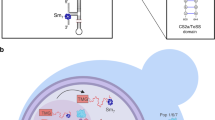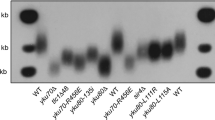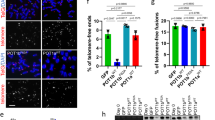Abstract
Telomere synthesis depends on telomerase, which contains an RNA subunit linked to a specialized reverse transcriptase subunit and several associated proteins. Here we report the characterization of four mutations in the yeast reverse transcriptase subunit Est2p that cause an overelongation of telomeres and an increase in the association of Est1p with telomeres during S phase. These 'up-mutations' are clustered in the finger subdomain of the reverse transcriptase. We show that the catalytic properties of the up-mutant telomerases are not improved in vitro. In vivo, the up-mutations neither bypass the activation step governed by Cdc13p nor do they uncouple telomerase from the Rap1p inhibition pathway. In the presence of the up-mutations, however, the ability of the Pif1p helicase to decrease telomere length and to inhibit the association of Est1p with telomeres is impaired. In addition, Pif1p associates in vivo with the telomerase RNA (TLC1) in a way that depends on the finger subdomain. We propose that, in addition to its catalytic role, the finger subdomain of Est2p facilitates the action of Pif1p at telomeres.
This is a preview of subscription content, access via your institution
Access options
Subscribe to this journal
Receive 12 print issues and online access
$189.00 per year
only $15.75 per issue
Buy this article
- Purchase on Springer Link
- Instant access to full article PDF
Prices may be subject to local taxes which are calculated during checkout





Similar content being viewed by others
References
Blackburn, E.H. The end of the (DNA) line. Nat. Struct. Biol. 7, 847–850 (2000).
Nakamura, T.M. et al. Telomerase catalytic subunit homologs from fission yeast and human. Science 277, 955–959 (1997).
Harrington, L. et al. Human telomerase contains evolutionarily conserved catalytic and structural subunits. Genes Dev. 11, 3109–3115 (1997).
Haering, C.H., Nakamura, T.M., Baumann, P. & Cech, T.R. Analysis of telomerase catalytic subunit mutants in vivo and in vitro in Schizosaccharomyces pombe. Proc. Natl. Acad. Sci. USA 97, 6367–6372 (2000).
Lingner, J. et al. Reverse transcriptase motifs in the catalytic subunit of telomerase. Science 276, 561–567 (1997).
Nakamura, T.M. et al. Telomerase catalytic subunit homologs from fission yeast and human. Science 277, 955–959 (1997).
Huang, H., Chopra, R., Verdine, G.L. & Harrison, S.C. Structure of a covalently trapped catalytic complex of HIV-1 reverse transcriptase: implications for drug resistance. Science 282, 1669–1675 (1998).
Bosoy, D. & Lue, N.F. Functional analysis of conserved residues in the putative 'finger' domain of telomerase reverse transcriptase. J. Biol. Chem. 276, 46305–46312 (2001).
Hossain, S., Singh, S. & Lue, N.F. Functional analysis of the C-terminal extension of telomerase reverse transcriptase. A putative 'thumb' domain. J. Biol. Chem. 277, 36174–36180 (2002).
Evans, S.K. & Lundblad, V. Est1 and Cdc13 as comediators of telomerase access. Science 286, 117–120 (1999).
Taggart, A.K., Teng, S.C. & Zakian, V.A. Est1p as a cell cycle-regulated activator of telomere-bound telomerase. Science 297, 1023–1026 (2002).
Smith, C.D., Smith, D.L., DeRisi, J.L. & Blackburn, E.H. Telomeric protein distributions and remodeling through the cell cycle in Saccharomyces cerevisiae. Mol. Biol. Cell 14, 556–570 (2003).
Fisher, T.S., Taggart, A.K. & Zakian, V.A. Cell cycle-dependent regulation of yeast telomerase by Ku. Nat. Struct. Mol. Biol. 11, 1198–1205 (2004).
Schramke, V. et al. RPA regulates telomerase action by providing Est1p access to chromosome ends. Nat. Genet. 36, 46–54 (2004).
Bianchi, A., Negrini, S. & Shore, D. Delivery of yeast telomerase to a DNA break depends on the recruitment functions of Cdc13 and Est1. Mol. Cell 16, 139–146 (2004).
Marcand, S., Gilson, E. & Shore, D. A protein-counting mechanism for telomere length regulation in yeast. Science 275, 986–990 (1997).
Boule, J.B., Vega, L.R. & Zakian, V.A. The yeast Pif1p helicase removes telomerase from telomeric DNA. Nature 438, 57–61 (2005).
Diede, S.J. & Gottschling, D.E. Telomerase-mediated telomere addition in vivo requires DNA primase and DNA polymerases α and δ. Cell 99, 723–733 (1999).
Marcand, S., Brevet, V., Mann, C. & Gilson, E. Cell cycle restriction of telomere elongation. Curr. Biol. 10, 487–490 (2000).
Hughes, T.R., Evans, S.K., Weilbaecher, R.G. & Lundblad, V. The Est3 protein is a subunit of yeast telomerase. Curr. Biol. 10, 809–812 (2000).
Schulz, V.P. & Zakian, V.A. The Saccharomyces PIF1 DNA helicase inhibits telomere elongation and de novo telomere formation. Cell 76, 145–155 (1994).
Zhou, J., Monson, E.K., Teng, S.C., Schulz, V.P. & Zakian, V.A. Pif1p helicase, a catalytic inhibitor of telomerase in yeast. Science 289, 771–774 (2000).
Zhang, D.H., Zhou, B., Huang, Y., Xu, L.X. & Zhou, J.Q. The human Pif1 helicase, a potential Escherichia coli RecD homologue, inhibits telomerase activity. Nucleic Acids Res. 34, 1393–1404 (2006).
Rothwell, P.J., Mitaksov, V. & Waksman, G. Motions of the fingers subdomain of klentaq1 are fast and not rate limiting: implications for the molecular basis of fidelity in DNA polymerases. Mol. Cell 19, 345–355 (2005).
Myung, K., Chen, C. & Kolodner, R.D. Multiple pathways cooperate in the suppression of genome instability in Saccharomyces cerevisiae. Nature 411, 1073–1076 (2001).
Budd, M.E., Reis, C.C., Smith, S., Myung, K. & Campbell, J.L. Evidence suggesting that Pif1 helicase functions in DNA replication with the Dna2 helicase/nuclease and DNA polymerase δ. Mol. Cell. Biol. 26, 2490–2500 (2006).
Schmelzle, T., Beck, T., Martin, D.E. & Hall, M.N. Activation of the RAS/cyclic AMP pathway suppresses a TOR deficiency in yeast. Mol. Cell. Biol. 24, 338–351 (2004).
Askree, S.H. et al. A genome-wide screen for Saccharomyces cerevisiae deletion mutants that affect telomere length. Proc. Natl. Acad. Sci. USA 101, 338–351 (2004).
Acknowledgements
We thank V. Zakian, J. Lopez, C. Ribeyre, A. Nicolas, D. Gottschling, T. Petes, D. Shore, M. Hall, M. Bickle, F. Letourneur and V. Lundblad for plasmids, strains and antibodies, A. Nicolas for critically reading the manuscript and T. Teixeira and B. Canard for discussion and advice. Work in E.G.'s and V.G.'s laboratories was supported by La Ligue Nationale contre le Cancer (Equipes labellisées); E.G.'s laboratory was also funded by European Contract FI6R-CT-2003-58842, named RISC-RAD; work in J.F.P.'s laboratory was supported by the CNR Programma biomolecole per la salute umana and COFIN-2001 (MURST); work in J.L.'s laboratory was supported by the Swiss National Science Foundation; C.L. was supported by a fellowship cofinanced by the Fondo Sociale Europeo and by the Ministero dell'Università e della Ricerca Scientifica e Tecnologica; and work by C.L. was done in fulfillment of the requirements for a joint doctoral degree in Genetics at the University of Naples 'Federico II' and at the Ecole Normale Supérieure (Lyon).
Author information
Authors and Affiliations
Contributions
A.E., C.L., M.B., P.L., E.S., A.-S.B., K.F. and Y.C. did and interpreted the experiments. A.P., J.L. and J.F.P. contributed to the design and interpretation of the experiments. V.G. and E.G. coordinated the whole work and cowrote the paper.
Corresponding author
Ethics declarations
Competing interests
The authors declare no competing financial interests.
Supplementary information
Supplementary Fig. 1
Expression of Est2p is not altered by the est2-up mutations (PDF 96 kb)
Supplementary Fig. 2
The est2-up mutations act downstream of telomerase recruitment (PDF 869 kb)
Rights and permissions
About this article
Cite this article
Eugster, A., Lanzuolo, C., Bonneton, M. et al. The finger subdomain of yeast telomerase cooperates with Pif1p to limit telomere elongation. Nat Struct Mol Biol 13, 734–739 (2006). https://doi.org/10.1038/nsmb1126
Received:
Accepted:
Published:
Issue Date:
DOI: https://doi.org/10.1038/nsmb1126
This article is cited by
-
Tandem affinity purification of AtTERT reveals putative interaction partners of plant telomerase in vivo
Protoplasma (2017)
-
To peep into Pif1 helicase: Multifaceted all the way from genome stability to repair-associated DNA synthesis
Journal of Microbiology (2014)
-
How telomeres are replicated
Nature Reviews Molecular Cell Biology (2007)



